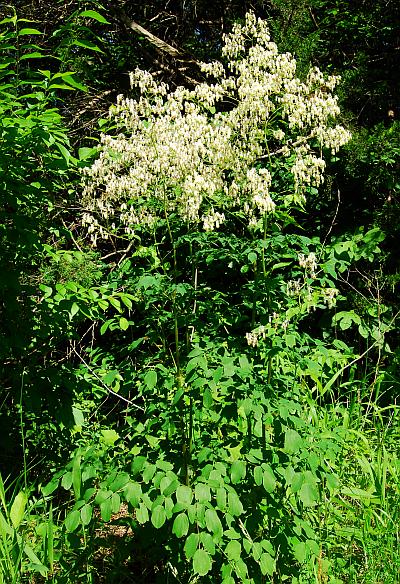Thalictrum revolutum DC.
Wax-Leaved Meadow-Rue

Native
CC = 5
CW = 0
MOC = 56
© SRTurner
Thalictrum revolutum DC.Wax-Leaved Meadow-Rue | |
 |
Native CC = 5 CW = 0 MOC = 56 |
© SRTurner |
|
Family - Ranunculaceae Habit - Rhizomatous, dioecious, perennial herb. Stems - Erect, to 1.5 m.
Leaves - Basal and alternate, 2-3 times ternately or ternately-pinnately compound, the lower leaves petiolate, the upper leaves sessile or nearly so. Leaflets to 5.5 cm long, mostly longer than wide, usually 3-lobed, the lobes bluntly pointed, the margins entire, narrowly revolute, the undersurface and stalk usually pubescent with gland-tipped hairs, less commonly glabrous or with only inconspicuous sessile glands.
Inflorescences - Panicles, the branches glabrous or pubescent with gland-tipped hairs, sometimes only with sessile glands.
Flowers - Flowers all or nearly all imperfect. Sepals 4, 3-4 mm long, white or sometimes purplish tinged. Filaments white or purplish-tinged. Petals absent. Pistils (3-)6-21, each with 1 ovule.
Fruits - Achenes 3-5 mm long, flattened-ellipsoid, the beak 2-3 mm long, becoming brittle with age and often shed, the surface glabrous or pubescent with gland-tipped hairs, sometimes only with sessile glands.
Flowering - May - August. Habitat - Streambanks, pond margins, fens, prairies, forest openings, roadsides. Origin - Native to the U.S. Other info. - The male plants of this species can be very showy when in bloom. It is found in scattered locations throughout most of the state, with the continental range mostly restricted to the eastern U.S. and Canada. The plants are easy to recognize but can be very difficult to identify to species. In particular, differentiation from T. dasycarpum can be virtually impossible for specimens having glabrous leaflets. Otherwise, look for stalked glands on the leaflet undersides. The leaflet margins are also revolute (rolled under), but this is not unique to the species. The crushed foliage has an peculiar odor which some people find unpleasant. Photographs taken at St. Joe State Park, St. Francois County, MO, 5-31-2010, 5-14-2012, and 6-2-2025, Shaw Nature Reserve, Franklin County, MO, 7-21-2012, Grasshopper Hollow, Reynolds County, MO, 6-15-2013, Barton fen, Iron County, MO, 6-16-2013, Matson Hill County Park, St. Charles County, MO, 5-23-2014 and 6-22-2021, Glassberg Conservation Area, Jefferson County, MO, 5-25-2017, and Poison Hollow, Howell County, MO, 6-11-2021 (SRTurner). |